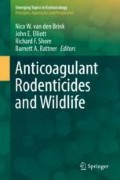Abstract
Rodents are known to affect human society globally in various adverse ways, resulting in a widespread demand for their continuous control. Anticoagulant rodenticides (ARs) have been, and currently remain, the cornerstone of rodent control throughout the world. Although alternative control methods exist, they are generally less effective. ARs work by affecting vitamin K metabolism, thereby preventing the activation of blood clotting factors and eventual coagulopathy. Since ARs are non-selective, their undoubted benefits for rodent control have to be balanced against the environmental risks that these compounds pose. Although they have been used for decades, pharmacokinetic and toxicokinetic data are mainly available for laboratory mammals and have concentrated on acute effects. Limited information is available on chronic exposure scenarios and for wildlife species. Important gaps exist in our understanding of the large inter- and intra-species differences in sensitivity to ARs, especially for non-target species, and in our knowledge about the occurrence and importance of sub-lethal effects in wildlife. It is clear that mere presence of AR residues in the body tissues may not indicate the occurrence of effects, although unequivocal assessment of effects under field conditions is difficult. Ante-mortem symptoms, like lethargy, subdued behaviour and unresponsiveness are generally not very specific as is true for more generic post-mortem observations (e.g. pallor of the mucous membranes or occurrence of haemorrhages). It is only by combining ante or post-mortem data with information on exposure that effects in the field may be confirmed. We do know however that a wide variety of non-target species are directly exposed to ARs. Secondary exposure in predators is also widespread although there is limited information on whether this exposure causes actual effects. Exposure is driven by ecological factors and is context specific with respect to spatial habitat configuration and bait placement. Another key factor that affects the interaction between ARs and wildlife is the development of resistance in target species. The development of resistance has resulted in higher use of SGARs, thereby increasing the potential of non-target and secondary exposure. AR use has increasingly become more strictly regulated, increasing the need for alternatives. Alternatives are available, including non-anticoagulant rodenticides, but these may also pose significant risk to environmental organisms, humans and pets. There are also various mitigation measures that can be implemented when using ARs, including bait protection, pulsed baiting at the onset of infestation, restricting use by non-professionals, and avoiding use in areas of high non-target density. Reduction in secondary exposure may result from e.g. non-chemical control, habitat management, and, in agricultural habitats, the use of lure crops and supplemental feeding. Such Integrated Pest Management (IPM) may not only reduce non-target exposure but also benefit resistance management. Barriers to adopt IPM approaches however, include the perception that they do not work or too slowly and are more laborious, expensive and time consuming. It is therefore important that the expectations of stakeholders are considered and managed. Nevertheless, further development of alternatives and IPM measures is essential, so the key research priority related to rodent control may ultimately be to address the lack of scientific assessment of the effectiveness of both specific AR mitigation measures and of IPM approaches to rodent control.
Access this chapter
Tax calculation will be finalised at checkout
Purchases are for personal use only
Author information
Authors and Affiliations
Corresponding author
Editor information
Editors and Affiliations
Rights and permissions
Copyright information
© 2018 Springer International Publishing AG
About this chapter
Cite this chapter
van den Brink, N.W., Elliott, J.E., Shore, R.F., Rattner, B.A. (2018). Anticoagulant Rodenticides and Wildlife: Concluding Remarks. In: van den Brink, N., Elliott, J., Shore, R., Rattner, B. (eds) Anticoagulant Rodenticides and Wildlife. Emerging Topics in Ecotoxicology, vol 5. Springer, Cham. https://doi.org/10.1007/978-3-319-64377-9_14
Download citation
DOI: https://doi.org/10.1007/978-3-319-64377-9_14
Published:
Publisher Name: Springer, Cham
Print ISBN: 978-3-319-64375-5
Online ISBN: 978-3-319-64377-9
eBook Packages: Earth and Environmental ScienceEarth and Environmental Science (R0)

